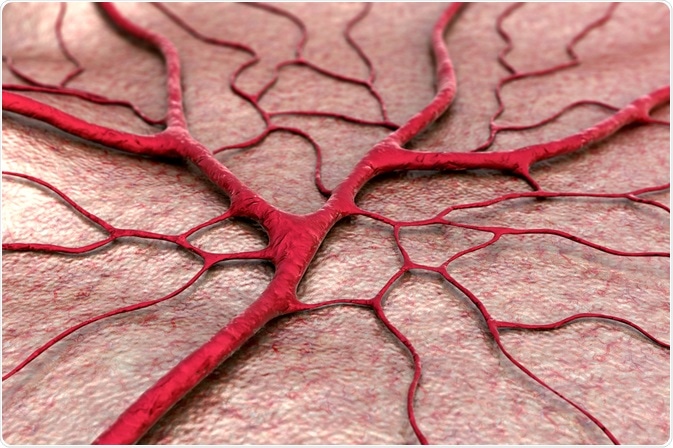Pericytes are cells that wrap around endothelial cells throughout the body. They are essential for the regulation of blood flow and maintenance of homeostasis within the body, such as the blood-brain barrier.

URGREEN 3S | Shutterstock
Pericyte structure
Pericytes are cells that wrap around the endothelial cells that line the capillaries and venules throughout the body. They are located in the basement membrane which allows them to communicate very efficiently.
Pericytes have a very prominent nucleus compared to the flat nucleus of endothelial cells, which allows them to easily be distinguished from endothelial cells. They also contain dendrite-like extensions that wrap around the capillary wall to regulate blood flow.
Pericytes can form direct connections with adjacent cells by forming gap junctions between them – this allows for the exchange of ions between both cells. Pericytes use integrins to communicate with endothelial cells that are not adjacent to them.
Heterogeneity in pericytes
The embryonic origin of pericytes is heterogeneous. Pericytes in the central nervous system, thymus, lungs, heart, liver, and gut originate from the ectoderm, while pericytes in most other organs originate from the mesoderm. As pericytes are heterogeneous, several markers exist that can be used to identify them.
Platelet-derived growth factor receptor β (PDGFRβ) is involved in the proliferation and recruitment of pericytes, nerve-glial antigen-2 (NG2) is involved in the recruitment of pericytes to tumor vasculature, CD146 is a transmembrane glycoprotein that functions as an adhesion molecule.
Many of the markers used are not pericyte-specific. Also, different pericytes vary in their expression of these markers which depends on the organ, development stage of the pericyte, and the maturation state of the pericyte.
Pericytes contribute to normal physiology and homeostasis
Pericytes control the flow of blood through blood vessels by extending their long projections around the contracting or relaxing endothelial vessel. Pericytes also contribute to the development, remodeling, architecture, and permeability of the vasculature.
Pericytes act with astrocytes within the brain to maintain the blood-brain barrier (BBB) integrity. They can also regulate lymphocyte activation to affect blood coagulation.
Pericytes and myogenesis
Pericytes contribute to the formation of skeletal muscle. Transplanting pericytes into host muscle causes them to fuse with myoblasts to form myotubes, which helps to regenerate muscle in cases of injury or necrosis. Pericytes can be cultured in vitro, so they can be used to treat muscular dystrophies.
The regenerative capacity of pericytes is affected by the host microenvironment. This is seen when pericytes were injected into older host animals and younger hosts during a study, and the older hosts animals generated fewer and smaller myofibers.
Pericytes and neurogenesis
The density of pericytes is highest, and they have several roles within the central nervous system microenvironment. Pericytes migrate to the source of traumatic brain injuries and differentiate into neural cells following ischaemic strokes. Pericytes can also be isolated from the cerebral cortex and reprogrammed into functional neurons.
Pericytes and angiogenesis
Pericytes promote endothelial cell survival and migration which aids in angiogenesis. In adults, pericytes only contribute to angiogenesis during wound healing and tumor growth. They aid in wound healing and reduce the growth of tumors.
Diseases related to pericytes
Diabetic retinopathy
Diabetic retinopathy is one of the leading causes of blindness and is a common complication of diabetes mellitus.
The disease is caused by the apoptosis of pericytes or their detachment from the basement membrane. This reduces the pericyte to endothelial cell ratio, which in turn reduces the number of functional blood vessels and disrupts the blood-retinal barrier. Retinopathy can also be caused by the growth of abnormal new blood vessels in the retina which leads to capillary blockages leading to blindness.
Neuropathy
Neuropathy is caused by hyperglycemia-induced apoptosis of pericytes in diabetic patients. The reduced number of pericytes leads to the disorganization of endothelial cells, resulting in decreased perfusion of nerves causing hypoxia. The hypoxia then causes oxidative stress and apoptosis of pericytes.
Ischemic strokes
Strokes are a leading cause of death and disability in the western part of the world. The neurovascular unit (NVU) contains neurons, endothelial cells, pericytes, astrocytes, microglia, and the extracellular matrix.
Damage or dysregulation of cells within the NVU (especially nerves and pericytes) can lead to ischemic strokes. Pericytes have many different roles that contribute to the progression of ischemic strokes.
Recent studies have discovered that pericytes constriction and death may cause the no-reflow phenomenon in brain capillaries which is seen during the hyperacute phase of stroke.
Pericytes also detach from the microvessels and mediate inflammatory immune responses which resulting in BBB damage and brain oedemas. The studies discovered that pericytes contribute to neuroprotection by stabilizing the BBB and protecting the endothelium. Pericytes also protect against strokes by contributing to angiogenesis and neurogenesis, which promotes neurological recovery.
Further Reading